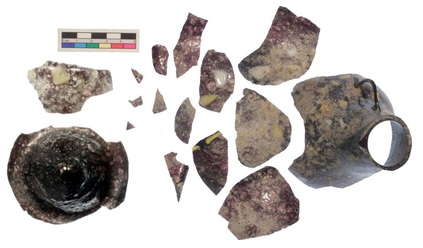Significance
The object is a small glass jug of free-blown glass, giving it a round body, which narrows into a cylindrical neck with a flared rim. There is a thin glass handle applied to one side of the neck/upper body which has been formed separately from four layers of the same glass as used for the body, folded, and bent into shape and attached when hot. The material used for the body is a dark purple translucent glass, to which has been applied blobs of opaque white and yellow glass, creating a dappled effect across the jug’s outer surface.
The object belongs to the Petrie Museum, and although it came to the museum via Petrie along with many other glass objects, he did not excavate them, but rather acquired them through a gift or purchase. Thus the jug has no recorded provenance, but stylistically it can be dated to the proto-Islamic Period (6th-8th centuries AD), and comes from the Middle East, possibly Egypt.
The object belongs to the Petrie Museum, and although it came to the museum via Petrie along with many other glass objects, he did not excavate them, but rather acquired them through a gift or purchase. Thus the jug has no recorded provenance, but stylistically it can be dated to the proto-Islamic Period (6th-8th centuries AD), and comes from the Middle East, possibly Egypt.
Pre-treatment condition
The jug arrived for treatment in 14 pieces; a large section of the upper body and neck was intact, with the handle. The rim was almost completely missing (and there were no rim sherds), but a small preserved section indicated that it was flared. A dry assembly of the object using tape on the inside (undamaged) surface showed that the base presented with the jug did not belong to this object. A further search in the Petrie Museum turned up two more pieces of the vessel.
There was a thin brown film over about 60% of the outer surface of the object (none on the inside). The film was not friable, but appears to be a hard encrustation. There were particles of sand and dirt in the brown layer (making it look brown) which probably entered the weathered layer during burial. Its absence from the interior surface indicated that the interior was protected from the dirt and sand.
There was a thin brown film over about 60% of the outer surface of the object (none on the inside). The film was not friable, but appears to be a hard encrustation. There were particles of sand and dirt in the brown layer (making it look brown) which probably entered the weathered layer during burial. Its absence from the interior surface indicated that the interior was protected from the dirt and sand.
Treatment
The owner requested that the object be reconstructed with Paraloid B72 (an ethyl methacrylate co-polymer) because not all of the pieces are present, and may someday be found. Paraloid B72 is reversible with solvents, so could be removed in this situation, and the object reconstructed. The owner also requested that backings and fills only be applied if required structurally.
The owner requested that the objects not be cleaned too thoroughly in case any archaeological evidence was lost. The object was dry-cleaned once over with vulcanised rubber sponge (Smoke Sponge) over the inner and outer surfaces. This removed a layer of dark dirt, resembling what is usually referred to as “museum dirt”.
The object was reconstructed using 40% weight/volume Paraloid B72 (an ethyl methacrylate copolymer) in acetone. The adhesive was lightly brushed along the edges of each join, then the edges were pushed together. In some instances, several sherds had to be joined at once, in order to find the correct alignment. During curing, the pieces were gently but firmly pressed together, because Paraloid B72 forms quite a thick film that would have caused misalignments. After curing, excess adhesive was removed using a scalpel and acetone swabs.
The owner requested that the objects not be cleaned too thoroughly in case any archaeological evidence was lost. The object was dry-cleaned once over with vulcanised rubber sponge (Smoke Sponge) over the inner and outer surfaces. This removed a layer of dark dirt, resembling what is usually referred to as “museum dirt”.
The object was reconstructed using 40% weight/volume Paraloid B72 (an ethyl methacrylate copolymer) in acetone. The adhesive was lightly brushed along the edges of each join, then the edges were pushed together. In some instances, several sherds had to be joined at once, in order to find the correct alignment. During curing, the pieces were gently but firmly pressed together, because Paraloid B72 forms quite a thick film that would have caused misalignments. After curing, excess adhesive was removed using a scalpel and acetone swabs.
Condition after treatment
The object is now in one piece, and can be handled, with care (as is true for all museum objects). The adhesive is known to be stable over a long period of time so it should stay stable for a long time.
Recommendations for further care
The object is stable, but care should be taken when handling as there are jagged edges, and it is still very delicate due to the nature of the material. Handling should be kept to a minimum because the deteriorated areas of the surface may become detached. I would not recommend wearing gloves to handle this object; the reduced sensitivity encourages a tighter grip, which puts the object at more risk than does bare hands.


